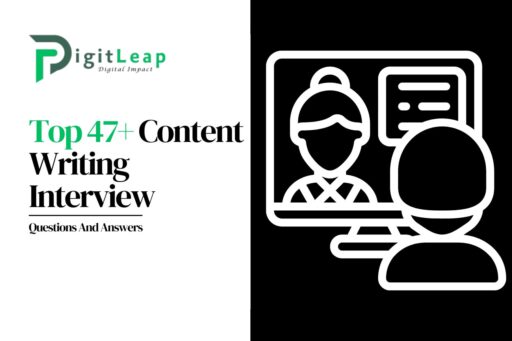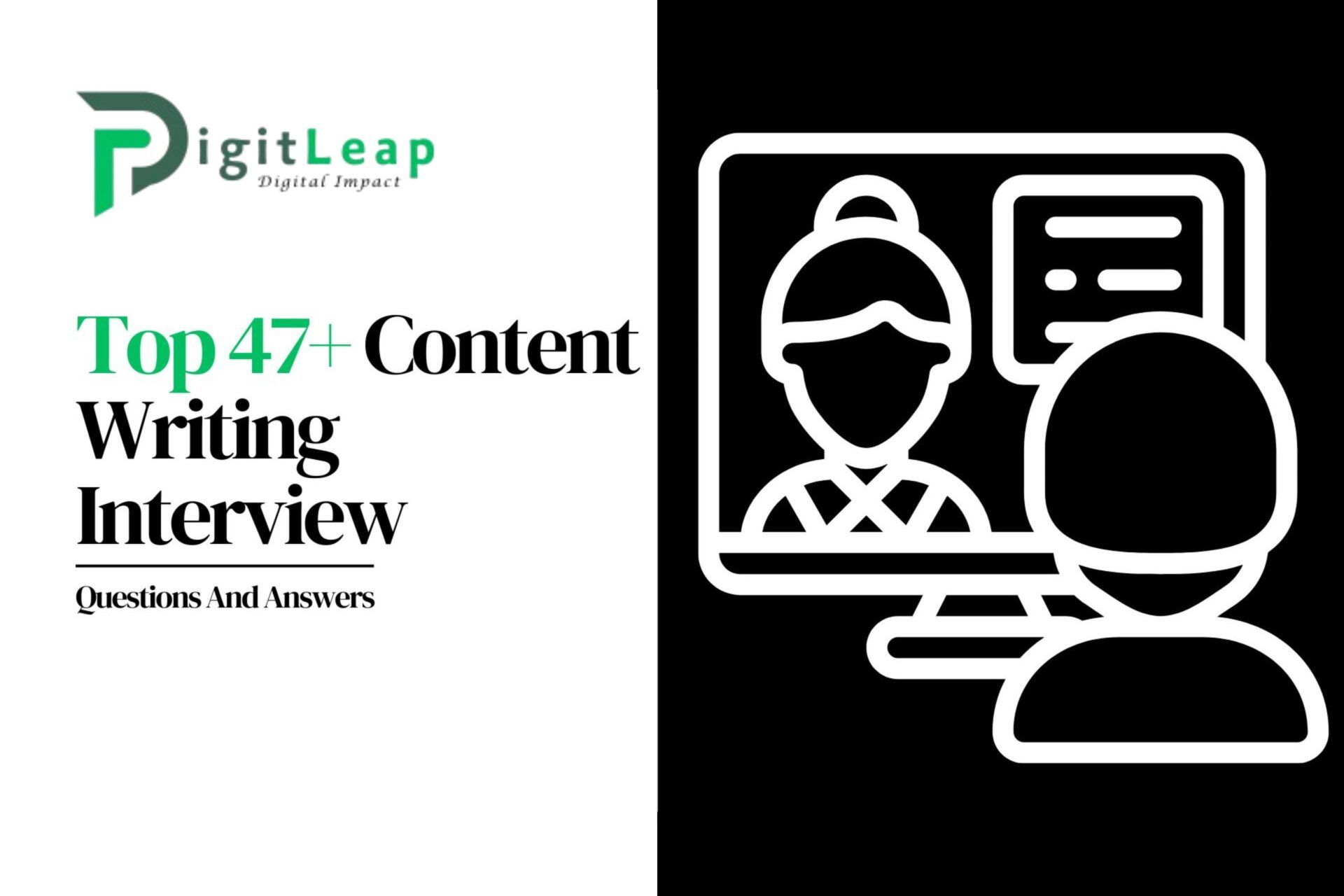Top 47 Content Writing Interview Questions and Answers in 2024
1. What is content writing, and why is it important?
Answer:
Content writing involves creating written material for various platforms, such as blogs, websites, social media, and marketing materials. It is crucial because it helps in engaging the audience, building brand authority, and driving traffic to websites through valuable and relevant content.
2. How do you approach writing content for different audiences?
Answer:
To write for different audiences, first identify their needs, interests, and preferences. Use appropriate language, tone, and style that resonate with each audience segment. Conduct research to understand the audience and tailor content to address their specific concerns and goals.
3. What are the key elements of a compelling blog post?
Answer:
A compelling blog post includes:
- Engaging Title: Captures attention and includes keywords.
- Introduction: Hooks readers and outlines what the post will cover.
- Body: Provides valuable information with clear headings and subheadings.
- Conclusion: Summarizes key points and includes a call-to-action (CTA).
- Visuals: Enhances the content with images, infographics, or videos.
4. How do you optimize content for SEO?
Answer:
Optimize content for SEO by:
- Keyword Research: Identify relevant keywords and integrate them naturally into the content.
- On-Page SEO: Use keywords in titles, headings, and meta descriptions.
- Content Quality: Ensure content is valuable, informative, and engaging.
- Internal Linking: Link to other relevant content on your site.
- Readability: Use short paragraphs, bullet points, and clear headings.
5. What is the difference between copywriting and content writing?
Answer:
Copywriting focuses on persuasive writing designed to drive specific actions, such as making a purchase or signing up for a newsletter. Content writing, on the other hand, aims to provide valuable information and engage readers, often with the goal of building trust and authority.
6. How do you handle writer’s block?
Answer:
Handle writer’s block by:
- Taking Breaks: Step away from the task to refresh your mind.
- Changing Environment: Work in a different location or setting.
- Reading: Consume content related to your topic to spark ideas.
- Free Writing: Write whatever comes to mind without worrying about structure.
7. How do you ensure accuracy in your content?
Answer:
Ensure accuracy by:
- Conducting Research: Use credible sources and verify facts.
- Cross-Checking Information: Confirm details from multiple sources.
- Proofreading: Review the content for errors and inconsistencies.
- Using Fact-Checking Tools: Leverage tools and resources to verify information.
8. What is a call-to-action (CTA), and why is it important?
Answer:
A CTA is a prompt that encourages readers to take a specific action, such as signing up for a newsletter or making a purchase. It is important because it guides the reader towards the next step and helps achieve the content’s goals.
9. How do you adapt your writing style for different platforms (e.g., blogs, social media, websites)?
Answer:
Adapt your writing style by:
- Understanding Platform Requirements: Tailor the tone, length, and format based on the platform.
- Audience Preferences: Consider what resonates with the audience on each platform.
- Purpose of Content: Adjust the style to match the content’s goal, whether it’s informative, promotional, or conversational.
10. What tools do you use for content writing and management?
Answer:
Common tools include:
- Word Processors: Microsoft Word, Google Docs.
- SEO Tools: SEMrush, Ahrefs, Google Keyword Planner.
- Grammar and Spell Checkers: Grammarly, Hemingway Editor.
- Content Management Systems (CMS): WordPress, Drupal.
- Project Management Tools: Trello, Asana.
11. How do you conduct research for a content piece?
Answer:
Conduct research by:
- Identifying Reliable Sources: Use academic journals, industry reports, and reputable websites.
- Gathering Data: Collect relevant statistics, facts, and expert opinions.
- Taking Notes: Organize information for easy reference.
- Verifying Information: Cross-check facts to ensure accuracy.
12. What is content curation, and how is it different from content creation?
Answer:
Content curation involves gathering and organizing existing content from various sources to provide valuable insights or updates to your audience. Content creation, on the other hand, involves producing original material from scratch.
13. How do you measure the effectiveness of your content?
Answer:
Measure effectiveness by analyzing metrics such as:
- Traffic: Number of visitors to the content.
- Engagement: Likes, shares, comments, and time spent on the page.
- Conversions: Actions taken by readers, such as signing up or making a purchase.
- SEO Performance: Keyword rankings and organic search traffic.
14. What is content repurposing, and why is it beneficial?
Answer:
Content repurposing involves adapting existing content into different formats, such as turning a blog post into an infographic or video. It is beneficial because it maximizes the value of your content and reaches different audience segments.
15. How do you stay updated with the latest trends in content writing?
Answer:
Stay updated by:
- Following Industry Blogs: Read posts from reputable content marketing and writing blogs.
- Attending Webinars and Conferences: Participate in industry events and workshops.
- Joining Professional Groups: Engage with communities on platforms like LinkedIn or Reddit.
- Continuing Education: Take online courses or certifications related to content writing.
16. What is the role of keywords in content writing?
Answer:
Keywords play a crucial role in content writing by helping to optimize content for search engines. They should be strategically placed in titles, headings, and throughout the text to improve search visibility and attract relevant traffic.
17. How do you handle tight deadlines for content delivery?
Answer:
Handle tight deadlines by:
- Prioritizing Tasks: Focus on the most important and time-sensitive tasks.
- Creating a Plan: Break down the content creation process into manageable steps.
- Avoiding Distractions: Minimize interruptions to stay focused.
- Communicating Clearly: Inform stakeholders of potential delays and manage expectations.
18. How do you ensure your content aligns with the brand’s voice and tone?
Answer:
Ensure alignment by:
- Understanding Brand Guidelines: Familiarize yourself with the brand’s voice and tone guidelines.
- Reviewing Previous Content: Analyze existing content to maintain consistency.
- Collaborating with Stakeholders: Get feedback from the brand’s team to ensure alignment.
- Adhering to Style Guides: Follow established style guides for writing and formatting.
19. What is content strategy, and how do you develop one?
Answer:
Content strategy is a plan that outlines how content will be created, distributed, and managed to achieve business goals. Develop one by:
- Defining Objectives: Set clear goals for your content.
- Understanding the Audience: Identify audience needs and preferences.
- Creating a Content Plan: Outline topics, formats, and distribution channels.
- Measuring Success: Use metrics to track and adjust the strategy as needed.
20. How do you deal with negative feedback on your content?
Answer:
Deal with negative feedback by:
- Listening Actively: Understand the concerns raised.
- Responding Professionally: Address the feedback constructively and courteously.
- Making Improvements: Use feedback to improve future content.
- Maintaining a Positive Attitude: View feedback as an opportunity for growth.
21. What is a content calendar, and why is it important?
Answer:
A content calendar is a schedule that outlines when and where content will be published. It is important because it helps in planning, organizing, and managing content production, ensuring timely and consistent delivery of content.
22. How do you approach writing content for different industries or niches?
Answer:
Approach writing for different industries by:
- Conducting Industry Research: Understand the industry’s trends, challenges, and terminology.
- Identifying Target Audience: Tailor content to the specific needs and interests of the audience.
- Adhering to Best Practices: Follow industry-specific guidelines and standards.
- Collaborating with Experts: Consult industry professionals to ensure accuracy.
23. What is the difference between long-form and short-form content?
Answer:
Long-Form Content: Typically exceeds 1,000 words and provides in-depth coverage of a topic, often used for detailed guides or comprehensive articles. Short-Form Content: Usually under 1,000 words and focuses on concise, easily digestible information, suitable for blog posts, social media updates, and news articles.
24. How do you handle content that needs to be updated or refreshed?
Answer:
Handle content updates by:
- Reviewing Existing Content: Identify outdated or inaccurate information.
- Conducting Research: Gather new data or insights to update the content.
- Making Revisions: Update the content with fresh information and improve clarity.
- Promoting Updates: Notify readers of significant changes or updates.
25. How do you ensure your content is original and not plagiarized?
Answer:
Ensure originality by:
- Writing from Scratch: Create unique content rather than copying from sources.
- Using Plagiarism Checkers: Verify content with tools like Copyscape or Grammarly.
- Citing Sources: Properly attribute any borrowed ideas or quotes.
- Maintaining Your Voice: Develop a distinct writing style and perspective.
26. What are some effective ways to improve content readability?
Answer:
Improve readability by:
- Using Simple Language: Avoid jargon and complex words.
- Breaking Up Text: Use headings, bullet points, and short paragraphs.
- Adding Visuals: Incorporate images, charts, or infographics to illustrate points.
- Using Readability Tools: Utilize tools like Hemingway Editor to assess and enhance readability.
27. What is the role of storytelling in content writing?
Answer:
Storytelling plays a crucial role in content writing by engaging readers emotionally and making content more relatable and memorable. It helps in presenting information in a compelling narrative that captures the audience’s interest and conveys key messages effectively.
28. How do you optimize content for social media?
Answer:
Optimize content for social media by:
- Crafting Shareable Headlines: Create engaging and catchy titles.
- Using Visuals: Include images, videos, or infographics to attract attention.
- Incorporating Hashtags: Use relevant hashtags to increase visibility.
- Tailoring Content: Adjust the format and style based on the platform.
29. How do you handle multiple content projects simultaneously?
Answer:
Handle multiple projects by:
- Prioritizing Tasks: Determine which projects are most urgent or important.
- Creating a Schedule: Develop a timeline for each project and stick to deadlines.
- Using Project Management Tools: Track progress and manage tasks efficiently.
- Delegating: If possible, delegate tasks to team members to share the workload.
30. What is the importance of a content brief, and how do you create one?
Answer:
A content brief outlines the objectives, target audience, key messages, and other details for a content piece. It is important because it provides clear guidelines and ensures that the content aligns with the goals and requirements. Create one by:
- Defining Objectives: Specify what the content should achieve.
- Identifying the Audience: Describe the target audience and their needs.
- Providing Key Information: Include relevant details, keywords, and format requirements.
- Setting Deadlines: Establish timelines for content delivery.
31. What is content personalization, and why is it important?
Answer:
Content personalization involves tailoring content to individual preferences and behaviors based on data such as browsing history, demographics, or past interactions. It is important because it increases relevance, engagement, and conversion rates by addressing the specific needs and interests of the audience.
32. How do you measure the ROI of content marketing?
Answer:
Measure ROI by:
- Tracking Metrics: Analyze performance metrics such as traffic, engagement, and conversions.
- Calculating Costs: Determine the costs associated with content creation and distribution.
- Evaluating Results: Compare the results with the costs to assess the return on investment.
- Using Analytics Tools: Leverage tools like Google Analytics to gather and analyze data.
33. What is the role of metadata in content writing?
Answer:
Metadata includes information about the content, such as title tags, meta descriptions, and alt text for images. It helps search engines understand and index content, improving SEO and enhancing the visibility of the content in search results.
34. How do you create engaging headlines?
Answer:
Create engaging headlines by:
- Using Powerful Words: Include words that evoke emotions or curiosity.
- Being Clear and Concise: Ensure the headline accurately reflects the content and is easy to understand.
- Incorporating Numbers: Use numbers to make headlines more specific and appealing.
- Testing Headlines: Experiment with different headlines to see which performs best.
35. What is content syndication, and how does it benefit a brand?
Answer:
Content syndication involves distributing content across multiple platforms or websites to reach a broader audience. It benefits a brand by increasing visibility, driving more traffic, and enhancing brand authority through exposure on reputable sites.
36. How do you maintain consistency in content across different channels?
Answer:
Maintain consistency by:
- Developing Brand Guidelines: Establish clear guidelines for tone, style, and messaging.
- Creating a Content Strategy: Ensure all content aligns with the overall strategy and objectives.
- Using Templates: Utilize content templates to standardize formats and styles.
- Regular Reviews: Conduct periodic reviews to ensure consistency across channels.
37. What are some common mistakes to avoid in content writing?
Answer:
Common mistakes include:
- Lack of Clarity: Failing to convey the message clearly.
- Ignoring SEO: Neglecting to optimize content for search engines.
- Overuse of Jargon: Using too much technical language that may confuse readers.
- Inconsistent Tone: Failing to maintain a consistent voice and style.
38. How do you ensure your content is inclusive and accessible?
Answer:
Ensure inclusivity and accessibility by:
- Using Inclusive Language: Avoid biased or discriminatory language.
- Providing Alt Text: Include descriptive text for images to assist visually impaired readers.
- Using Clear Formatting: Structure content with headings and bullet points for easy navigation.
- Ensuring Readability: Write in simple, straightforward language.
39. What is the role of analytics in content writing?
Answer:
Analytics play a crucial role by providing insights into content performance, such as traffic, engagement, and conversions. They help in understanding what works and what doesn’t, allowing for data-driven decisions to improve content strategy and effectiveness.
40. How do you handle content for diverse cultural audiences?
Answer:
Handle content for diverse audiences by:
- Researching Cultural Norms: Understand cultural preferences, taboos, and language nuances.
- Localizing Content: Adapt content to fit cultural contexts and local preferences.
- Avoiding Stereotypes: Steer clear of generalizations and ensure respectful representation.
- Consulting Local Experts: Get feedback from native speakers or cultural experts.
41. What is the significance of a strong opening sentence in content writing?
Answer:
A strong opening sentence is significant because it captures the reader’s attention and encourages them to continue reading. It sets the tone for the content and provides a preview of what’s to come, making it crucial for engagement.
42. How do you approach writing for technical subjects or industries?
Answer:
Approach writing for technical subjects by:
- Understanding the Topic: Gain a thorough understanding of the subject matter.
- Simplifying Complex Information: Break down complex concepts into simple, digestible parts.
- Using Examples: Provide real-world examples to illustrate technical points.
- Consulting Experts: Seek input from industry experts to ensure accuracy.
43. What is the importance of editing and proofreading in content writing?
Answer:
Editing and proofreading are important because they ensure the content is free of errors, inconsistencies, and inaccuracies. They improve clarity, readability, and overall quality, enhancing the credibility and professionalism of the content.
44. How do you handle feedback and revisions from clients or stakeholders?
Answer:
Handle feedback by:
- Listening Carefully: Understand the feedback and its context.
- Responding Professionally: Address feedback constructively and make necessary revisions.
- Clarifying Requirements: If needed, ask for more details to ensure you meet expectations.
- Implementing Changes: Adjust the content based on the feedback while maintaining quality.
45. What is the role of visual content in writing?
Answer:
Visual content, such as images, infographics, and videos, enhances writing by breaking up text, illustrating points, and making content more engaging. It helps to capture attention, improve understanding, and increase retention.
46. How do you ensure your content is engaging and holds the reader’s attention?
Answer:
Ensure engagement by:
- Using a Captivating Opening: Start with an interesting hook.
- Providing Value: Offer useful and relevant information.
- Incorporating Visuals: Use images, videos, or infographics to enhance the content.
- Using a Conversational Tone: Write in a friendly and approachable style.
47. What is the importance of a strong conclusion in content writing?
Answer:
A strong conclusion summarizes key points and reinforces the main message. It often includes a call-to-action (CTA), guiding readers on what to do next, and leaving a lasting impression.
Other Important Q&A List :
- OOPs Interview Questions And Answers
- SQL Interview Questions and Answers
- Content Writing Interview Questions and Answers
- Email Marketing Interview Questions and Answers
- Django Interview Questions and Answers
- C Programming Interview Questions and Answers
- ReactJS Interview Questions and Answers
- Angular Interview Questions and Answers
- Power BI Interview Questions and Answers
- Top DBMS Interview Questions and Answers
- Python Interview Questions and Answers
- MySQL Interview Questions and Answers
- Java Interview Questions and Answers
- Data Structures Interview Questions
- Flutter Interview Questions and Answers
- JavaScript Interview Questions and Answers
- PHP Interview Questions and Answers
- CSS Interview Questions and Answers
- HTML Interview Questions and Answers






